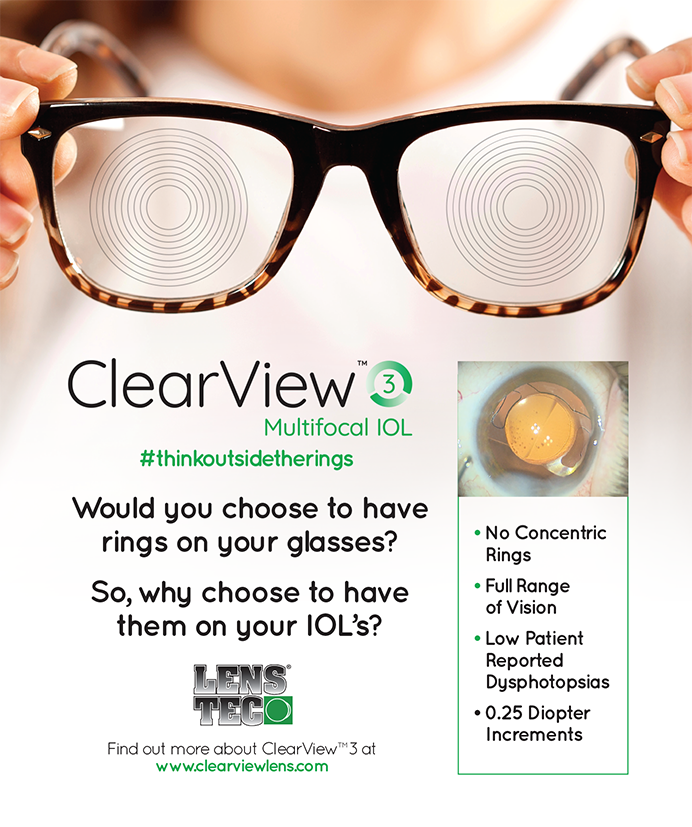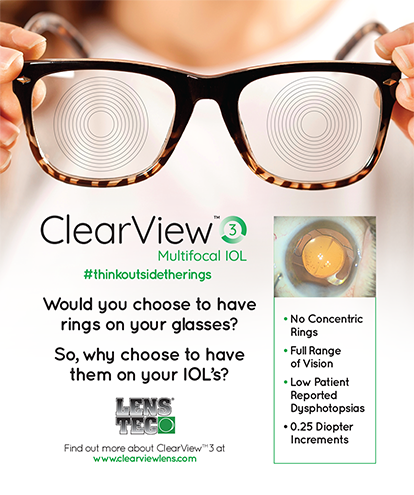From personal cameras and video recorders to mainstream television, imaging in every aspect of people's lives is moving toward a digital platform. In the ophthalmic OR today, surgeons commonly perform procedures through a microscope and record them in two dimensions through microscope-mounted cameras. In what some have termed a paradigm shift, digital imaging now enables surgeons to perform and record microsurgical procedures with heads-up, high-definition, three-dimensional (3D) displays rather than through microscope oculars.
I recently incorporated the TrueVision surgical vision system (TrueVision Systems, Inc., Santa Barbara, CA) into my OR and have found its impact on visitors and staff to be profound. I have used this real-time, 3D, high-definition system for both primary and secondary visualization in anterior segment surgery, including cataract, refractive, glaucoma, cornea, and strabismus procedures. This article describes the benefits of TrueVision based on my experience.
ABOUT THE SYSTEM
TrueVision includes three primary components. First is a 3D video camera that attaches to the microscope in line with or in place of the microscope oculars and contains two high-definition sensors that emulate the binocular system's depth of field. Second is a workstation that processes the images through a dual projection system. Finally, there is a widescreen display panel. Once each second, the camera streams nearly 2 GB of data, and the computer interprets the information to display 3D high-definition video in real time.
As for a 3D movie, customized spectacles combine right and left stereo images that, for the first time, enable patients, students, and staff to see precisely the same view that the surgeon sees (Figure 1). With the addition of innovative cataract tool set software applications, newer generations of this system that are in the works may surpass the capabilities of the current microscope by allowing for more precise, standardized refractive outcomes.
EDUCATION IN 3D
Three-dimensional technical advances are helping surgeons to capture and display real-time surgery and play it back to audiences for educational purposes. In November 2008, stereo video from TrueVision debuted as part of an educational course on microincisional cataract surgery that I taught during the AAO Annual Meeting. With a chopping technique, many of the motions are in the vertical plane, and the biggest challenge is learning how deeply to position the chopper and phaco tip. It can be difficult for students to appreciate the correct depth for optimal holding with the phaco needle and separating with the chopper. The 3D platform and its increased depth of field permitted students to see precisely how deep the instruments are placed.
Similarly, one of the challenges of adopting biaxial phacoemulsification, with a separation of I/A, has been learning the most effective placement of the phaco tip and irrigating chopper relative to each other in the vertical plane. If the stream of irrigating fluid washes material away from the phaco tip, it prolongs the procedure and may set the stage for problems if a piece of nucleus is forgotten in the angle or the sulcus. In addition, keeping the stream high up in the chamber in cases of intraoperative floppy iris syndrome prevents the iris from billowing and prolapsing. Three-dimensional high-definition imagery facilitates ophthalmologists' understanding of the critical vertical dimension in these techniques.
The educational applications of 3D microsurgery are not limited to video demonstrations at professional meetings. Three-dimensional images can be played back or viewed directly during surgery as education for patients and their families. In my experience, this type of visual display seems to demystify the surgery: it shows patients what I am doing in the eye and fosters their knowledge about the procedure. It is wonderful for patients and their family members to see a cataract procedure with this sort of "wow factor" and insight that two-dimensional viewing does not offer. The feedback I have received has been consistently positive. In fact, the wife of one of my patients who watched her husband's cataract surgery actually commented that she could not wait to undergo the procedure herself. Seeing the surgery live in 3D completely removed her anxiety.
I have also found the images projected on the visual display to be a wonderful teaching tool for my OR staff. In the standard OR setup, the surgeon is the only person who has a full stereoscopic view. The 3D display has increased synergy in the OR, because my scrub nurses can understand when I have a problem and can anticipate the next instrument needed. Surgeons can use their peripheral vision to transfer instruments easily, safely, and efficiently. A more involved staff improves the workflow in the OR.
LEARNING CURVE
As humans are creatures of habit, some surgeons may initially be reluctant to switch to performing surgery via a 3D, widescreen platform. To facilitate the transition, I recommend keeping the traditional oculars in place by using a stereo bridge, a setup that allows surgeons to revert to using the oculars as they learn to rely on a projected image.
I found that the learning curve was simply a leap of faith—the decision not to look through the oculars and to rely instead on the projected, wide-screen image. I related this psychological hurdle to my experiences in outdoor education and high ropes challenge courses: balancing on or jumping from a pole 50 feet above the ground simply requires an internal decision to overcome fear. The actual physical environment in this situation is carefully controlled and quite safe. Similarly, the surgical procedure progressed smoothly once I made the commitment. In my office, it took only five or six procedures for me to perfect the illumination and positioning of the screen before that "circuit" in my mind changed, and I was no longer reaching for the microscope with my eyes.
An important secondary, ergonomic benefit of the TrueVision system is reduced strain on my neck and back. The projected image on a screen means I no longer have to look down in a microscope for extended periods of time. My traditional microscope setup was already optimized to reduce the strain on my neck. With the upright display, I have found it necessary to alter my direction of gaze slightly because of obstruction from the strut that supports the optical system of the microscope. I have to look a little to the left or right to perform surgery. With eventual modifications to the microscope and camera design, it will be possible to achieve straight-on, unobstructed visualization.
PRACTICAL TIP
A trade-off in 3D high-definition imaging is a reduction of resolution. It is therefore important to obtain the highest-resolution visual object as an input to the digital camera. I noticed, for example, a significant improvement in imaging with the use of the Lumera microscope's Dual Stereo Coaxial Illumination (Carl Zeiss Meditec, Inc., Dublin, CA). Several of my colleagues have also noticed the dramatic clarity, resolution, and color that can be achieved with this microscope.
FUTURE APPLICATIONS
As with any new technology, surgeons' feedback sparks new designs and software applications. The next steps in development for 3D surgical imagery include higher-resolution images, a more compact display to maximize OR space, expanded indications into other subspecialties such as retinal and neurosurgery, and an ophthalmic tool set that will overlay metric data on the 3D screen to help guide the placement of cataract and limbal relaxing incisions as well as the sizing of the capsulorhexis.
Today, surgeons generally estimate the diameter of the capsulorhexis based on the pupil's size. For an unusual case, they may utilize a forceps with an engraved ruler (eg, the Seibel Rhexis Ruler [MicroSurgical Technology, Redmond, WA]). The TrueVision Ophthalmic Tool Set software provides a digital template for sizing and creating the capsulorhexis based on an image captured preoperatively at the slit lamp. The tool set also offers a template for performing limbal relaxing incisions. The guiding image marker for the incisions is superimposed on the eye, then sized and rotated correctly for a more precise astigmatic correction. Amazingly, the arcuate guides can be locked onto the surgical view of the eye so that they move with the eye and maintain the correct relationship to the cornea's steep axis.
CONCLUSION
There are tremendous applications for 3D surgery in ophthalmology, from education to archiving to enhancing surgical outcomes. As this technology moves forward through incision marking with the ophthalmic tool set, the capabilities of 3D surgery will surpass what is available with the standard microscope.
Mark Packer, MD, is a clinical associate professor, Casey Eye Institute, Department of Ophthalmology, Oregon Health and Science University, and is in private practice with Drs. Fine, Hoffman & Packer, LLC, in Eugene, Oregon. He is a consultant to Carl Zeiss Meditec, Inc., and TrueVision Systems, Inc. Dr. Packer may be reached at (541) 687-2110 mpacker@finemd.com.


